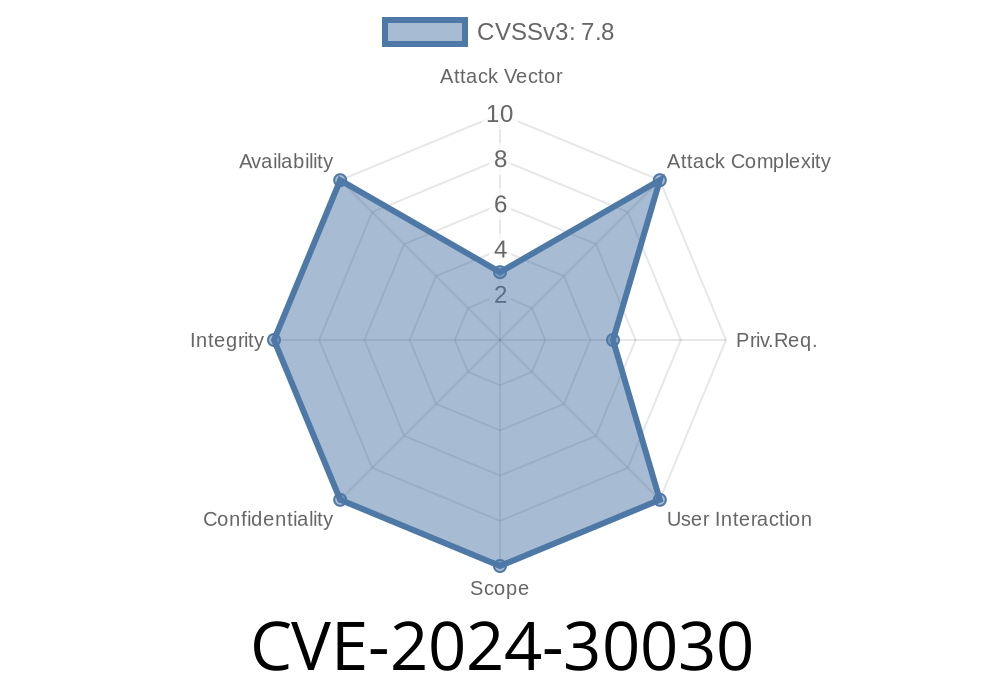Computer security breaches threaten businesses and individuals alike consistently across the world. Among the many types of vulnerabilities, one stands out: elevation of privilege (EoP) attacks. In this blog post, we will dive into the details of a specific EoP vulnerability known as CVE-2024-30030 that exists within the Windows operating system's Win32k component. We'll discuss why this vulnerability is dangerous, reveal how it can be exploited, and provide references to mitigation techniques.
Background
The Win32k component is responsible for managing a variety of operations for the Windows operating system. It includes window management, font handling, and other core functionalities central to the user experience. Due to these critical duties, any vulnerability within the Win32k component can have significant security implications.
In this case, CVE-2024-30030 represents an EoP vulnerability that leaves attackers with opportunities to gain unauthorized access to potentially confidential data, cause damage, or execute malicious actions within the compromised system.
Exploit Details
This specific Win32k EoP vulnerability allows an attacker who has low-privilege access to a target system to potentially elevate their access level to SYSTEM privileges. This is done by exploiting the way Win32k handles certain memory operations, leading to type confusion.
To better understand this vulnerability, we'll need to look at a code snippet that demonstrates how an attacker could exploit this flaw:
#include <Windows.h>
int main(void) {
/* Allocation of memory for malicious payload. */
void *malicious_payload = VirtualAlloc(NULL, x100, MEM_COMMIT | MEM_RESERVE, PAGE_EXECUTE_READWRITE);
/* Crafting the malicious payload. */
memcpy(malicious_payload, "\x90\x90\x90\x90" /* NOP sled */
"\xCC" /* Breakpoint */
"\x90\x90\x90\x90"
"\xC3" /* RET */
, 9);
LoadLibraryA("user32.dll");
/* Triggering the vulnerability, leading to EoP. */
SendMessageA(HWND_BROADCAST, WM_HOTKEY, MAKELONG(x1337, x16), (LPARAM)malicious_payload);
}
In the code snippet above, the attacker first allocates a buffer using VirtualAlloc() and then prepares a malicious payload inside the buffer. This payload could include a wide array of damaging functions, such as opening a reverse shell or extracting sensitive information. The attacker then triggers the vulnerability via the SendMessageA() function, which leads to the execution of the malicious payload with elevated privileges.
References for deeper understanding of this vulnerability and related exploits can be found in the following articles:
1. CVE-2024-30030 Official Documentation by MITRE
2. EoP Exploit Walkthrough for Win32k
3. In-Depth Analysis of CVE-2024-30030
Mitigations
To protect against CVE-2024-30030, the first and most important step is to ensure that all software and systems are up to date with the latest security updates provided by Microsoft. These updates typically address various security vulnerabilities, including CVE-2024-30030, as well as other potential threats.
Vendors and developers who need to remediate this vulnerability can reference the following guidelines:
1. Microsoft's Security Guidance for CVE-2024-30030
2. Vendor Remediation Guidelines for CVE-2024-30030
Conclusion
While CVE-2024-30030 is a dangerous vulnerability affecting the Win32k component within Windows operating systems, with proper patching and vigilance, systems can be effectively protected. Administrators, developers, and users alike must verify they are using up-to-date software and follow the guidelines provided to reduce the risk of exploitation. We hope this blog post has provided valuable insight into the Win32k Elevation of Privilege Vulnerability (CVE-2024-30030) and what you can do to stay safe.
Timeline
Published on: 05/14/2024 17:17:02 UTC
Last modified on: 06/19/2024 20:58:41 UTC
